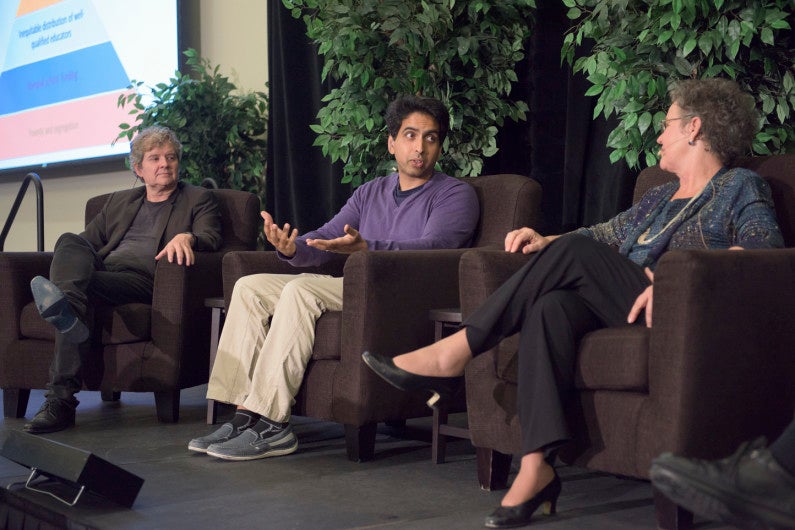America needs political will to fix unjust educational system, Stanford experts say
The OpenXChange event featured three influential education experts on policy, groundbreaking research and game-changing educational technologies.
At a recent campus discussion on the “crisis” of inequity in education, a panel of experts with views from ground zero unabashedly called out a critical missing piece to the solution: political will.
Investing in education has produced proven returns, yet the obvious fix remains elusive, according to the panelists at the April 27 event, titled “Combating Inequity in Education: A Critical Conversation About the Path Toward Education Equity in America.” The discussion, sponsored by Stanford’s OpenXChange initiative, featured three influential education experts on policy, groundbreaking research and game-changing educational technologies.

Sean Reardon, Salman Khan and Linda Darling-Hammond were the panelists at the OpenXChange discussion on “Combating Inequity in Education.” (Image credit: L.A. Cicero)
“We know the answer. We know it’s a good investment, and all the economists are saying it. Why wouldn’t we do it?” said Sean Reardon, the endowed Professor of Poverty and Inequality in Education at the Graduate School of Education. “It makes an enormous amount of sense from any angle you look at it, except we don’t do it.”
“Maybe we need a teacher to run for president,” said Linda Darling-Hammond, the Charles E. Ducommun Professor of Education, Emerita, at Stanford and president of the Learning Policy Institute.
Darling-Hammond, who founded the Stanford Center for Opportunity Policy in Education and the School Redesign Network, also served as the founding director of the National Commission on Teaching and America’s Future from 1994 to 2001 and as the leader of President Obama’s education policy transition team in 2008.
Reardon and Darling-Hammond were joined by Salman Khan, founder and CEO of Khan Academy, a nonprofit provider of free educational online videos. With over 37 million registered students in 190 countries, Khan Academy is one of the fastest growing educational platforms used by students and teachers.
Widespread inequity
The panelists agreed that tackling the longstanding issue of inequity in education is more pressing than ever given the widening gap in socioeconomic inequality. Surmounting research, including a new study by Reardon published today, has clearly shown the achievement gaps between the rich and poor.
The gap in test scores between high-income and low-income students is 40 percent larger now than it was about 40 years ago, Reardon said. And his latest study that analyzed test scores from every school district in the United States from 2009 to 2013 revealed a strikingly strong correlation between socioeconomic status and the academic performance of students by the time they enter middle school.
Indeed, the U.S. educational system “has been in crisis for a long time” and is failing to provide a foundation for many students, said Stanford President John Hennessy, who moderated the conversation.
“If the educational system creates inequality from the beginning, then that inequality will go through our entire society,” he said.
When Hennessy noted how Finland treats teachers like professionals with commensurate salaries, Darling-Hammond quickly responded: “We are the richest country in the world. Why can’t we do this? It’s crazy!”
Sobering statistics and problems of financial inequity across school districts anchored parts of the discussion, but not without glimmers of hope.
“We’ve had these problems for what feels like forever, but it doesn’t mean that we can’t fix it,” Reardon said.
When Connecticut revamped its educational system and raised teacher salaries across districts, the state rose to the top in every category in assessments – a result of teacher quality, Darling-Hammond said.
Wise spending urged
But money is not the end-all answer either. Instead, it’s allocating money in the places where it is needed, Darling-Hammond said.

Education Professor Emerita Linda Darling-Hammond is now president of the Learning Policy Institute, a national nonprofit, nonpartisan organization focused on public education pre-K through high school. (Image credit: L.A. Cicero)
There are schools that build new buildings and swimming pools, but nothing related to learning for the kids, she noted.
Smaller class sizes, skilled administrators and retaining quality teachers are all part of the equation. But investing in “wrap-around services,” such as improving student health and providing better access to vision or dental care, also makes a difference, Darling-Hammond said.
Technology can play an important role as well, Khan said. His academy is trying to address the problem of access to curricula for both poor and affluent school districts.
In addition, “personalized education” is “something that computers are good at,” he said.
Khan Academy, he said, has partnered with the College Board to develop more efficient ways to prepare students for college entrance exams, such as by diagnosing areas of weakness, which allows for teachers and students to intervene earlier when needed.
The event’s co-sponsors included Stanford Pre-Education Society (SPREES); Girls Teaching Girls to Code; GSB/GSE Education Club; CS + Social Good; Habla; Center for Comparative Studies in Race and Ethnicity; Office of Community Engagement and Diversity; Diversity and First-Gen Office; Graduate School of Education; Haas Center for Public Service; Office for Religious Life; Vice Provost for Graduate Education; Vice Provost for Teaching and Learning; and Vice Provost for Undergraduate Education.
